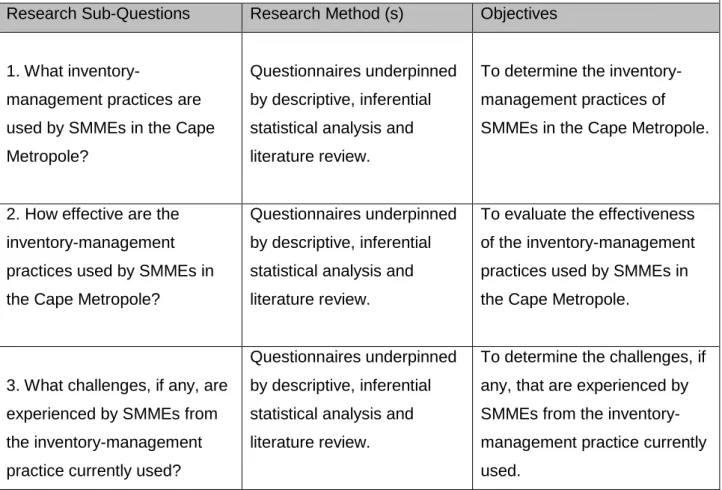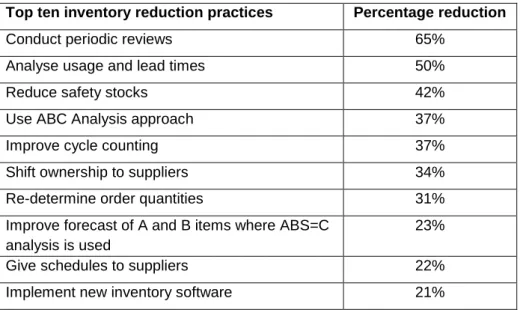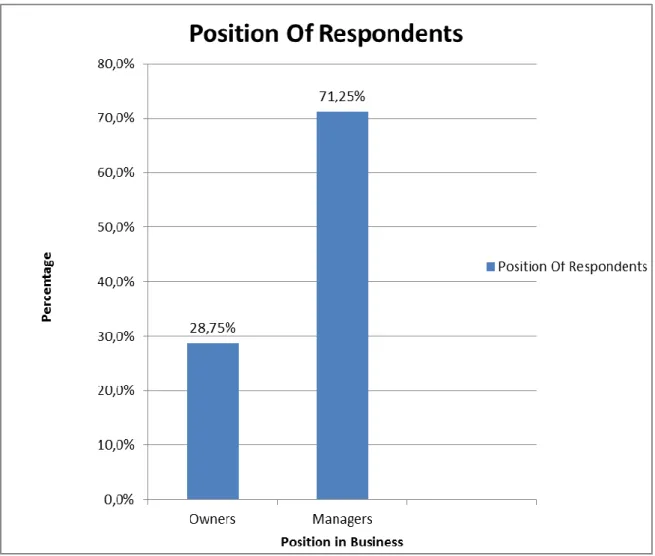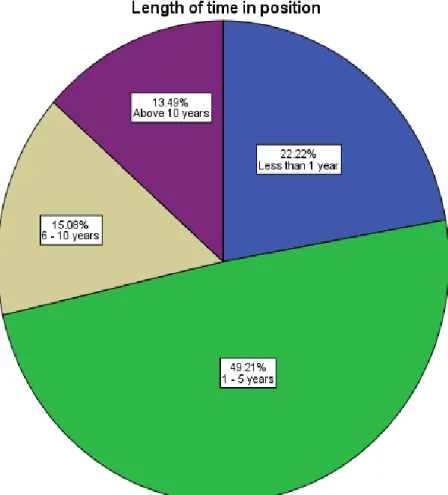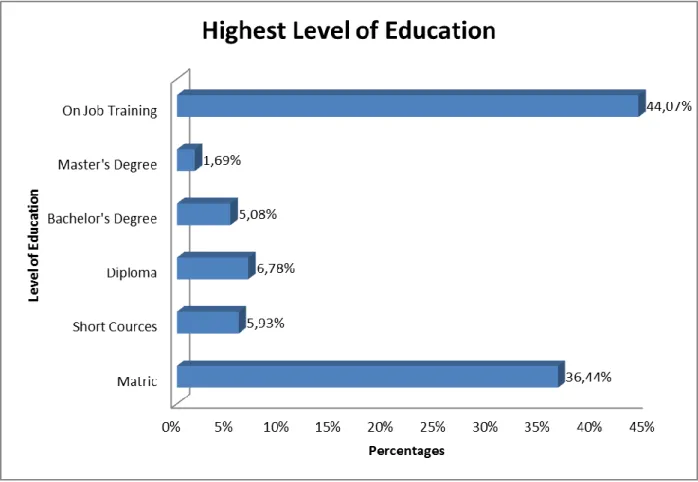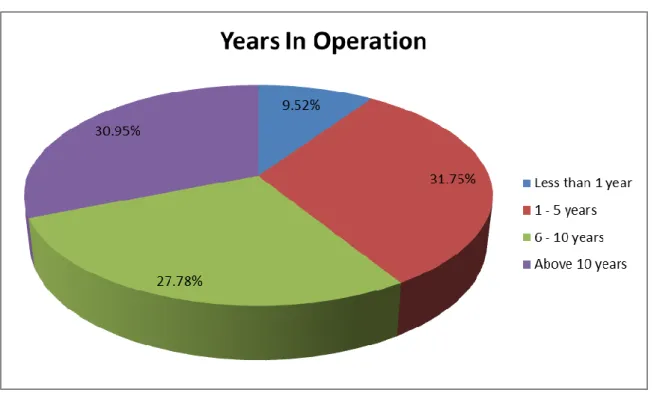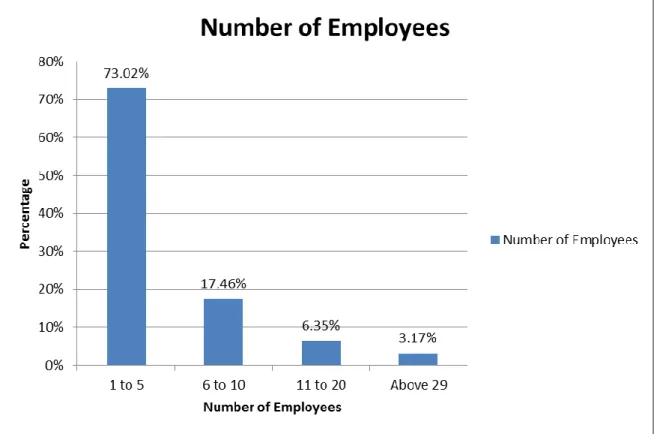Using a questionnaire survey, this study sought to determine the inventory management practices of SMEs operating in the Cape Metropolis, and to evaluate the effectiveness of the inventory management practices currently used by these entities. In addition, the study sought to determine the challenges, if any, experienced by MSMEs from the inventory management practices currently in use.
BACKGROUND
Indeed, Mbonyane (2006) partially attributes the high failure rate of SMMVs to ineffective use or lack of sound inventory management practices. Accordingly, there is very little research evidence on inventory management practices of SMMVs in South Africa (Peel & Wilson, 2000:01).
STATEMENT OF RESEARCH PROBLEM
Despite the benefits of sound inventory management, only a few studies have been conducted on the uptake of these practices by SMEs in South Africa (Silver, 2007:17). Still other studies have adopted an equally comprehensive approach by examining working capital management practices of SMEs (Phenya, 2011).
PURPOSE STATEMENT AND RESEARCH QUESTIONS
Purpose Statement
To evaluate the effectiveness of inventory management practices used by SMEs in the Cape Metropole. The purpose of the study is to determine inventory management practices of SMEs in the Cape Metropole.
Research Question, Sub-Questions, Research Methods and Objectives
RESEARCH DESIGN
- Empirical Study
- Sampling Method
- Data Collection, Analysis and Interpretation
- Ethical Consideration
The purpose of the study will be explained and a brief overview of the methodology will be discussed. Given that the proposed study will involve human participants, ethical guidelines as specified by the Cape Peninsula University of Technology Research Ethics Committee will be adhered to.
DELINEATION OF RESEARCH
The survey will not collect any identifying information of any respondents as all responses will be recorded anonymously. Furthermore, respondents will be assured that their information will be kept in strict confidence and used only for research purposes.
SIGNIFICANCE OF RESEARCH
The respondents will also be informed that their participation is voluntary, and that they can withdraw from the study at any time if they so wish. Participants will be thanked in writing for their participation and involvement in the study, and will be provided with an option to receive a copy of the findings of the proposed study upon completion.
LIMITATIONS
In addition, the proposed study will encourage owners and managers of small and medium enterprises to acquire good inventory management skills if the skill is found to be lacking, or even encourage them to invest their finances in accounting professionals with knowledge and experience of good inventory management.
CONTRIBUTION OF THE RESEARCH
VALIDITY
RELIABILITY
OUTLINE OF RESEARCH STUDY
INTRODUCTION
DEFINITION, CLASSIFICATION AND IMPORTANCE OF SMMES
Definition
Classification
Importance of SMMEs
In the South African context, SMEs have increasingly played an important role in the country's economic development as large enterprises are dramatically restructuring and downsizing. The latter not only promotes specialization, but also improves the country's productivity (Fjose, Grunfeld & Green, 2010).
INVENTORY MANAGEMENT
- Definition of Inventory Management
- Importance of effective Inventory Management
- Main types of Inventory Management models and systems
- Economic Order Quantity (EOQ)
- Just in Time (JIT)
- ABC Analysis
- Rule of Thumb
- Inventory reduction practices
Effective inventory management (IM) requires an analysis of the costs associated with maintaining certain inventory levels, as there are costs associated with holding too much inventory and those associated with keeping too little inventory (Atrill, 2006). Another inventory management system that can be used by small and medium-sized businesses is the ABC analysis system.
A REVIEW OF PRIOR STUDIES ON INVENTORY-MANAGEMENT PRACTICES OF
In addition, the study covered working capital management practices in a broad sense and thus did not focus on inventory management. In addition, managers and accountants did not respond differently to the inventory management practices that SMEs need to operate effectively.
A REVIEW OF PRIOR STUDIES ON THE EFFECTIVENESS OF INVENTORY-
Silver (2008) suggests that more attention should be paid to the behavioral aspects of inventory management. This suggests that the ineffectiveness of inventory management techniques may be the result of a 'lack of cooperation' from users.
A REVIEW OF PRIOR STUDIES ON THE CHALLENGES FACED BY SMMEs WHEN
It tried to identify problems in the company and improve the performance of the system. The sample size was ten SMEs and three large manufacturers in the east of the UK.
GAPS IDENTIFIED IN THE PRIOR LITERATURE
Some of the studies were conducted among large companies, operating in sectors other than the FMCG sector; Therefore, their findings may not be generalizable to SMEs operating in the FMCG sector. Some of the studies were conducted in the West African region and were in the form of a "case study".
CHAPTER SUMMARY AND CONCLUSION
With the aforementioned gaps in previous studies, many areas in inventory management remain unresolved. It is clear from the review of previous studies that the understanding of inventory management practices still seems evasive in the South African context.
INTRODUCTION
RESEARCH PARADIGM
Third, the positivist paradigm was chosen because of its objectivity, as quantitative data are more reliable to use. Due to the latter, the paradigm allows the researcher to use a large sample size, which ultimately improves the generalizability of the results obtained.
JUSTIFICATION FOR QUESTIONNAIRE SURVEY METHODOLOGY
Fourth, the paradigm was chosen due to time and financial constraints, as it requires the use of methods that are relatively quick and relatively inexpensive to administer, such as the questionnaire survey.
RESEARCH POPULATION AND SAMPLING TECHNIQUE
DESCRIPTION OF SECTIONS OF THE QUESTIONNAIRE
In the fourth part, respondents were asked to assess how frequently they experienced theft of inventory in the company. In the thirteenth, respondents were asked to rate how often they experienced an increase in inventory costs.
PILOT TESTING
In the ninth part, respondents were asked to indicate the frequency with which they experienced an increase in the number of damaged stocks. In the twelfth part, respondents were asked to indicate the frequency with which they experienced errors due to incompetent staff.
DATA COLLECTION PROCESS
The researcher was then advised to remove some questions that did not match the main purpose of the research and align the sections in the questionnaire with the research objectives. In such cases, answering the questionnaire took slightly longer than the average time indicated above.
DATA ANALYSIS
No questionnaires were administered via e-mail and only 9% remained for respondents to answer at their convenience.
RELIABILITY AND VALIDITY OF THE RESEARCH INSTRUMENT
Reliability of Research Instrument
Validity of the Research Instrument
- Internal validity
- External validity
- Cronbach’s Alpha
Are the questions in the questionnaire relevant to the purpose of the questionnaire (Lawrence, 2006:242). To increase reliability, the researcher calculated the Cronbach's Alpha coefficient to determine the internal consistency of the items in the questionnaire (Cronbach, 1951).
LIMITATIONS OF QUESTIONNAIRE SURVEY
Many of the respondents were foreign nationals, Muslim in faith and very conservative in dress. Knowing that there are thousands of small businesses in the Cape Metropole, the above sample size may not be representative of the entire population.
ETHICAL CONSIDERATION
It also helped tremendously when it was emphasized that respondents were free to answer any question they did not feel comfortable with. It was also ensured that the respondents understood that they would not be compensated for participating in the study.
CHAPTER SUMMARY AND CONCLUSION
It was also mentioned that the study was approved by the ethics committee of CPUT and that there was no risk associated with participating in the study. Respondents were also assured that the information provided would be treated confidentially and that their assistance would greatly benefit the SMME sector in South Africa.
INTRODUCTION
As summarized in Table 4.4 above, 56% of respondents indicated that their company insured inventory in the warehouse. This was followed by an analysis and discussion of the results on the inventory management practices of SMEs in the Cape Metropolis.

RESTATEMENT OR RESEARCH OBJECTIVES
RESPONSE RATE
This is followed by an analysis and discussion of the results on the effectiveness of inventory management practices. Inventory management practices among manufacturing SMEs in the Cape Metropole, Western Cape Province, South Africa.
RESPONDENTS’ BUSINESS PROFILE AND PERSONAL PROFILE
Respondents’ position in the business
Regarding the respondent's position in the business, the analysis of the results indicated that 71.25% of the respondents were managers, while 28.75% were the owners of the businesses (see Figure 4.1). Considering that all the respondents were either owners or managers, it can be concluded that the appropriate respondents were selected to participate in the study as they were the key respondents targeted by the study.
Respondents’ years of experience
Respondents’ highest level of education
Section B of the questionnaire aimed to examine the types of inventory management practices of SMEs operating in the Cape Metropolitan Area. Regarding the inventory management practices of SMEs in the Cape Metropolis, the results revealed that 81.88% of respondents relied on common sense to determine the amount of inventory to order.
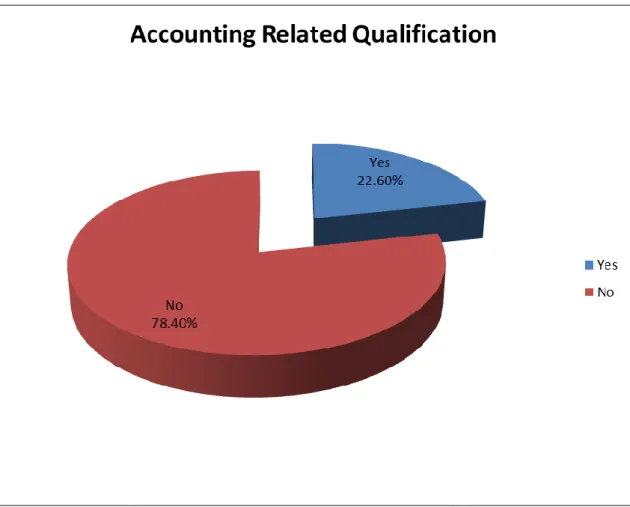
Whether respondents’ highest level of education was accounting related
Respondents’ business length of time in operation
Regarding the length of time the businesses had been in operation, 31.75% of respondents indicated that their businesses had been in operation for between one and five years, while 30.95% indicated that their businesses had been in operation for over ten years. Of the respondents, 27.78% indicated that their businesses had been in operation for between six to ten years, while only 9.52% of the respondents indicated that their businesses had been in operation for less than one year (see Figure 4.5 ).
Respondents’ business number of employees
Respondents’ business industry
Non-Response Bias
Only a minority (49.2%) of respondents indicated that their warehouse personnel verify delivery, receipt and storage of inventory. Interestingly, none of the respondents indicated that their business faced a larger inventory with an expiration date (0%).
TYPE OF INVENTORY-MANAGEMENT PRACTICES USED BY SMMEs
Ordering of stock by SMMEs
As summarized in Table 4.2, most respondents (81.88%) indicated that their companies rely on common sense to determine the amount of inventory to order, while 80.16% indicated that companies order bulk inventory to take advantage of trade discounts. Likewise, 40.16% of respondents indicated that their companies placed automatic orders when inventory reached a certain level.

Whether businesses use warehousing space
Of the respondents, 50% indicated that access to the warehouse was restricted to authorized personnel only. Hence, it fills the gap in knowledge by examining the inventory management practices mainly used by SMEs.

Whether businesses are in ownership of warehouse & insurance
Whether businesses plan in advance before ordering inventory
To investigate whether there is a significant difference between the percentage of respondents who plan before ordering inventory and those who did not, a Binomial Test was performed. These results are consistent with those of Bekker and Staude (1996), who stated that small business owners and managers fail to plan because of their ignorance and lack of vision, which precipitates a lack of specific goals and ideals. , lack of information based on which to make assumptions about the future as well as lack of discipline.
Whether businesses prepare inventory budgets
The results highlight a significant difference between the percentage who planned (90.3%) and the percentage who did not plan (9.7%) (p<0.05). A Binominal Test (2 tailed) was performed and no significant difference was found between the percentage of respondents who prepared inventory budgets (55.65%) and those who did not (44.35%) (p<0.05).
Whether businesses compare inventory ordered to the budgets regularly
The results of the present study are consistent with the findings of Maduekwe and Kamala (2016) who found that 67% of SMEs in Cape Metropole used inventory budgets.
Whether businesses update their inventory budgets regularly
The main purpose of this chapter was to analyze and discuss the results of the questionnaire survey conducted to investigate inventory management practices of SMEs in Cape Metropole, South Africa. This is followed by a summary and conclusion of the literature review on inventory management practices presented in Chapter Two, in Section 5.3.
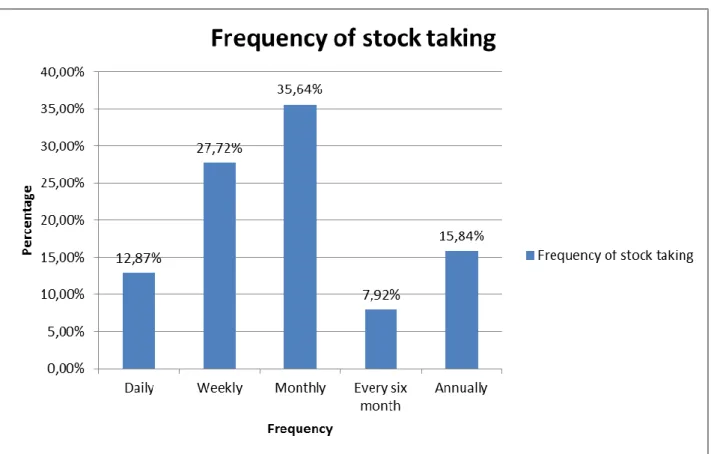
Whether business conduct stocktaking
Frequency of stocktaking
As illustrated in Figure 4.9, results indicate that 35.64% of the respondents' businesses do their stocktaking monthly; 27.72% do their inventory weekly, while 15.84%. These results are in contrast to the findings of Enow (2016), as most small businesses take inventory weekly instead of monthly.
Whether businesses track the movement of inventory from time of order till
Whether businesses have dedicated staff that manage the warehouse
Inventory control by staff in the warehouse
As summarized in Table 4.6 above, 88.5% reported that any discrepancy in supplied inventory is reported to senior personnel, while 86.8% indicated that removal of inventory should be authorized by senior personnel. Similarly, only a minority (45.9%) indicated that their company has clear procedures that are followed by staff when receiving and dispensing supplies from our warehouse.
Whether businesses need a warehouse
Of the respondents, 12.8% stated that their businesses do not need a warehouse because they cannot afford one; 11.9% indicated that their businesses do not need a warehouse because they purchase inventory from suppliers and deliver directly to customers. Likewise, only 9.6% specified that their businesses do not need a warehouse because they do not deal in perishable goods that can be stored in warehouses, while 2.4% indicated that their businesses do not need a warehouse because they only order one item. when a customer. orders from them.
CHALLENGES FACED WHEN MANAGING STOCK BY SMMEs
Frequency of inventory related challenges experienced by SMMEs
SUMMARY AND CONCLUSION
The results showed that 81.88% of SMEs relied on common sense to determine the amount of inventory to order. Theft was the most common challenge and was made by only 24% of SMEs.
INTRODUCTION
CHAPTER 1 – RESEARCH PROBLEM, QUESTION AND SUB-QUESTION
Problem Statement
Purpose Statement
Main Research Question
Research Sub-Questions
This study therefore adds to the body of knowledge insights into inventory management practices of small businesses, which are the lifeblood of the South African economy. Finally, most of the questions used in this study to assess inventory management were Likert scale questions.
CHAPTER 3 – SUMMARY AND CONCLUSION OF RESEARCH DESIGN AND
CHAPTER 4 – SUMMARY OF ANALYSIS AND DISCUSSION OF RESULTS
Population, response rate, respondents and business profiles
Regarding the number of employees in the surveyed company, 73.02% indicated that their company had between one and five employees, while 17.46% of companies had between six and ten employees. According to the industry of the companies surveyed, the results showed that 68.06% of the companies were in the food and beverage industry, 19.44% of the companies were in the household and.
Inventory-management practices used by SMMEs
The above has confirmed that the sample is derived from the FMCG sector and consists of micro and small business enterprises and therefore the respondents would be suitable participants for this research.
Use of warehousing
Stocktaking
Of the respondents, 50% have followed the movement of inventory from the moment the order is placed until the moment the stock is received, while 46.7% have employed dedicated staff to manage their warehouse.
Warehousing controls
Reasons for lack of warehousing facilities
Challenges faced in the usage of Inventory-management practices
It is the first study to investigate the use of inventory management practices in SMMEs in the FMCG sector of the Cape Metropole. You are invited to participate in a research study entitled “Inventory management practices of Small, Medium and Micro Enterprises (SMME) in the Cape Metropole”.
CONTRIBUTIONS AND SIGNIFICANCE OF THE STUDY
Contribution of this study
Fifth, this study examined four key inventory management practices, while other previous studies examined the use of a single IM practice. These courses can then be offered specifically to small businesses and used to improve the use of best inventory management practices among SMEs.
Significance of the study
Finally, the findings can also be applied to curriculum creation using the guidelines provided by the results of this study to inform the structure of short courses that can be offered in training institutions.
LIMITATIONS OF THE STUDY
Another limitation of the study was that some respondents were unwilling to provide information that they considered sensitive and confidential for their organization. Despite the aforementioned limitations, the findings of this study are relevant to the body of knowledge inventory management.
SUGGESTIONS FOR FURTHER RESEARCH
Firstly, a follow-up study could also be carried out on the same topic in the Cape Metropolis to monitor and evaluate improvements in the use of inventory management practices. An evaluation of inventory turnover in the Fortune 500 industrial companies”, Production and Inventory Management Journal, Vol.
